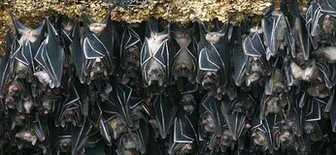Fruit Bats Protectionist in Davao Named a Disney Conservation Hero
Fruit bats conservation and protection in the Philippines
After tireless efforts on bat protection in her family-owned Monfort Bat Cave, Norma Monfort finally caught the attention of the global community as she is acclaimed a Disney Worldwide Conservation Fund Hero.
Nominated by the Bat Conservation International (BCI), Monfort is among the few selected heroes recognized as “ordinary individuals who are passionate about protecting animals and habitats in areas of critical concern”.
This is an annual award of the Disney Worldwide Conservation Fund (DWCF), focused on the study and protection of the world's wildlife and ecosystems, involving communities and addressing human needs.
The DWCF has taken Walt Disney’s legacy across the globe with more than $15 million in grants across 110 countries. The DWCF is funded by Disney and donations from Guests of Walt Disney World Resort, including Disney’s Animal Kingdom Theme Park, Disney Vacation Club and Disney Cruise Line.
It was Monfort who asked assistance from BCI to help her maintain and preserve the Monfort Cave as this is believed to be the world’s largest-known colony of Geoffroy’s rousette fruit bats, located in a cave on Samal Island, Davao, Philippines.

Monfort considers the award a great honor as an international organization like Disney appreciates her efforts in bat conservation.
She welcomed scientists, students, and all sort of people into her property where there is about 1.8 million of bats living in a uniquely-configured cave.
Appreciating the importance of scientific studies in developing the life of bats, the Monfort Bat Cave has also become a home for scientists specializing in bats.
One of them is Rick Sherwin from Virginia, USA who loves to frequent Samal Island, and immerse himself in the Monfort Cave to study the cycle of bats from day until night.
It is only in Monfort Cave that makes it so easy for scientists to observe bats. After a thorough study, Sherwin strongly believes the reason why most bats from neighboring areas flocked and opted to stay in Monfort Cave is the high calcium content of the cave wall.
“We’ve noticed that these bats are eating cave walls, as we checked these walls, we found that they are rich in calcium. Other caves do not have walls similar to Monfort’s,” he said.
He predicts that these bats will stay in that cave for thousands of years.
Realizing another problem of a highly congested bat sanctuary, Sherwin came back to Monfort’s along with other scientists to check the possibility of creating new habitats for these fruit bats.
Recently, Norma Monfort welcomed Linsey George and Ambre Graham both from Christopher Newport University. They will immerse themselves at Monfort’s for six months to observe and study bat cycles to forward Sherwin’s goal of building new habitats for the bats. (PIA XI/Mai Gevera-Macapagat)


